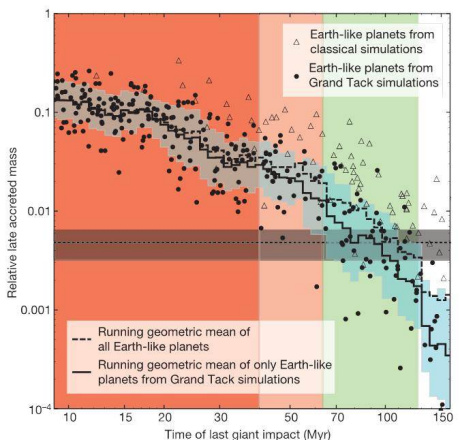
Seth Jacobson, Alessandro Morbidelli, Sean Raymond, Dave O’Brien, Kevin Walsh, David Rubie
Nature 508, 84 (2014)
http://dx.doi.org/10.1038/nature13172
Planetary scientists from BGI, France and the USA, funded by the European Research Council (ERC), dated the formation of the Moon using a newly established ‘clock’ to 95 +/- 32 million years after the beginning of the Solar System. They simulated the growth of the terrestrial planets (Mercury, Venus, Earth and Mars) from a disk of thousands of planetary building blocks orbiting the Sun. By analyzing the growth history of the Earth-like planets from more than 250 simulations, they discovered a relationship between the time of the Moon-forming event and the amount of material the Earth accretes after that giant collision, shown in Figure 1.
An estimate for the mass accreted by the Earth after the Moon-forming event is obtained from measurements of the highly siderophile elements. In order to understand its estimation one needs to appreciate that the giant impact also initiated the final round of core formation in the Earth. In this process, iron as well as the highly siderophile elements are segregated to the core. Thus, the abundance of the highly siderophile elements remaining in the Earth’s mantle is directly proportional to the mass accreted onto the Earth after the Moon-forming collision. Consequently, a measurement of the highly siderophile budget of the mantle provides the relative late accreted mass of the Earth necessary in order to use this clock for dating the Moon-forming event.
Efforts to date this Moon-forming event on the basis of radioactive isotope measurements have proposed a range of ages: some have argued for an early event, at around 30 million years after the birth of the Solar System, whereas others suggest that it occurred later than 50 million years, and possibly as late as 100 million years, after the Solar System formed. This new method is the very first geologic clock discovered that ticks in early Solar System history that does not rely on measurements and interpretations of the radioactive decay of atomic nuclei and so it affirms the late interpretations of the radiometric data.

Figure 1: The time of the last giant impact and the amount of mass accreted after that impact relative to the final mass is shown for each Earth-like planet. Triangles are Earth-like planets from classical simulations and circles are those from Grand Tack simulations. The black staircase is a running geometric mean of the Earth-like planets from Grand Tack simulations and the cyan-band indicates the 1σ uncertainty; the dashed staircase is the running geometric mean for all the Earth-like planets. The dashed line is the estimate of the late accreted mass for the Earth from the highly siderophile elements and the gray region indicates its uncertainty. The background colors indicate whether those times are consistent (green), inconsistent with 85% confidence (pink) or inconsistent with 99.9% confidence (red).
Tel: +49-(0) 921 55 3700 / 3766, Fax: +49-(0) 921 55 3769, E-mail: bayerisches.geoinstitut(at)uni-bayreuth.de